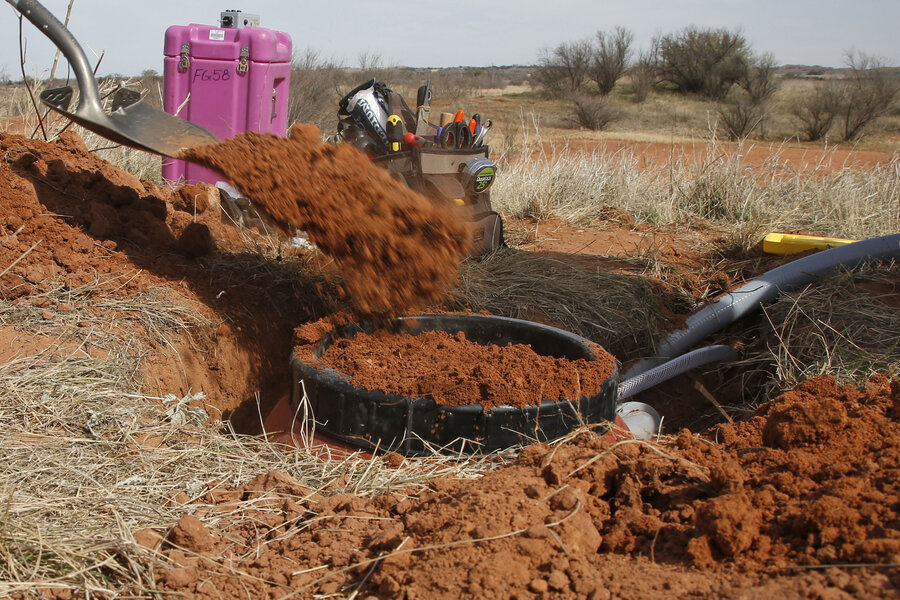How state regulations can prevent man-made earthquakes
Oklahomans aren't just imagining it. The state has experienced 100 fewer earthquakes thus far this year than it had by August, 2015.
Geologists tentatively attribute this decrease in tremors to increased regulations on the fracking and oil extraction industries, whose wastewater disposal practices have wreaked seismic havoc in Oklahoma and other states. Still, experts caution, it's too early to tell if the quake swarms have been permanently quelled.
“Steps to reduce waste water injection were a necessary and prudent step for Oklahoma to take,” USGS geophysicist George Choy tells The Christian Science Monitor in a telephone interview. “But the reduction has been taking place for only a few months.”
Oklahomans have experienced 110 fewer earthquakes measuring 3.0 on the Richter scale or more this year than last year, according to the US Geological Survey, which has measured just 448 earthquakes thus far this year, compared to 558 by this time last year.
A rash of at least 22 earthquakes took place in Oklahoma in a 13-hour period early this January. Most of the quakes occurred in the same geographic area – Woods County. Just one year before, the Oklahoma Geological Survey (OGS) had issued a report, attributing many of the state’s recent earthquakes to oil related drilling.
According to Oklahoma state seismologists Richard Andrews and Austen Holland, the rise in quakes over the past few years is "very unlikely to represent a naturally occurring process,” although the Oklahoma Oil and Gas Association expressed doubt about the existence of a firm connection between drilling and seismic activity.
Still, the rise in Oklahoma temblors is astounding. In 2008, there were just two earthquakes that measured 3.0-magnitude or greater. In 2015, there were 890, according to the USGS.
Although pro-fracking groups disputed the OSG’s conclusions last year, the decline in frequency of seismic events has occurred after the implementation of several regulatory measures intended to stem the processes that could be contributing to earthquakes.
Fracking and other types of oil extraction require a great deal of water, which becomes contaminated through the process and must be safely disposed of. In order to prevent polluting drinking water, oil extraction companies dispose of the salty, contaminant-laden wastewater far below the ground.
When the water is injected into the ground, it causes stress where there was not stress before. According to the USGS's Dr. Choy, the combined influence of the water and that stress can cause existing faults to slip, thereby creating earthquakes.
Many of the regulations that Oklahoma has instituted since March, 2015, are targeted at reducing that stress. Oil extractors now use a “traffic light system” to monitor seismic activity and guide their disposal practices, reducing their activity in an area that is beginning to look stressed.
Companies also take more care to avoid geological faults, in order to refrain from adding stress.
“Looking closely at the area, doing more monitoring, mapping faults, and having a deeper understanding of how injections are triggering seismic activity can lower the number of earthquakes,” says anti-fracking group Food and Water Watch representative, Hugh MacMillan in a phone interview with the Monitor.
Experts caution against assuming that these regulations have eliminated the problem, however.
“It would be premature to conclude that long-term earthquake activity has gone down permanently based on short-term data,” says Choy. “It took a long time for the situation to build up, and it may take years for it to ramp down.”
Nevertheless, the approach has seemed to spur progress in other states. In January, the Monitor’s Henry Gass reported on neighboring Kansas’ approach to combatting its own earthquake problem. Kansas has experienced a similar growth in earthquake frequency to Oklahoma.
While the director of the Kansas Corporation Commission, Ryan Hoffman, told the Monitor that there is likely no one size fits all solution to water injection caused earthquakes, the state has had success with its own regulatory measures, which include placing injection limits on wells, a rule that Oklahoma has now also put into play.
Experts say that, as with all things, greater perspective and knowledge will help shape regulation in the future, and that only time will tell which measures work, and how effective they are.
"Truthfully I don't think Oklahoma regulators were aware of all [seismic] fault lines Oklahoma had, and with more investigation they’ve found more," Interstate Oil and Gas Compact Commission spokesperson Carol Booth told the Monitor in January. "Now they have a full scope of what they have to their knowledge right now and will put in the regulations needed to prevent further [seismic] activity."







